
Frequent midday naps may be refreshing, but the urge to take them could be a symptom of something more serious.
Researchers from Johns Hopkins University have found that adults who report daytime sleepiness were almost three times more likely to develop deposits of beta amyloid proteins in the brain, which has long been associated with Alzheimer’s disease, than those who do not.
“Factors like diet, exercise and cognitive activity have been widely recognized as important potential targets for Alzheimer’s disease prevention, but sleep hasn’t quite risen to that status—although that may well be changing,” Adam Spira, PhD, an associate professor in the Department of Mental Health at the Johns Hopkins Bloomberg School of Public Health, said in a statement.
“If disturbed sleep contributes to Alzheimer’s disease, we may be able to treat patients with sleep issues to avoid these negative outcomes,” he added.
The researchers examined data from the Baltimore Longitudinal Study of Aging (BLSA), a long-term study that began in 1958, following the health of volunteers as they age. Between 1991 and 2000, the volunteers filled out questionnaires about their sleeping habits.
A subgroup of the study volunteers also received neuroimaging assessments, beginning in 1994. Also, in 2005, another subgroup of participants received a positron emission tomography (PET) scan using Pittsburgh compound B (PiB)—a radioactive compound that helps to identify amyloid plaques in neuronal tissue.
The team found 123 participants who both answered the questionnaire in the 90s and had a PET scan with PiB an average of almost 16 years later. The researchers then analyzed the data to try to find a correlation between participants who reported daytime sleepiness or took daytime naps and whether they scored positive for beta-amyloid deposition in their brains.
Before adjusting for demographic factors like age, sex, education and body-mass index, the researchers found that those who reported daytime sleepiness were about three times more likely to have beta-amyloid depositions than those who did not.
After adjusting for the demographic factors, the team found a risk that was still 2.75 times higher for those who reported daytime sleepiness.
According to Spira, it is not yet fully understood why daytime sleepiness was correlated with the deposition of beta-amyloid protein. He said one theory is that daytime sleepiness could cause the proteins to form.
However, previous research suggests that disturbed sleep due to factors like sleep apnea causes beta-amyloid plaques to form through an unknown mechanism.
Animal studies in Alzheimer’s disease models have shown that restricting nighttime sleep can lead to more beta-amyloid protein in the brain and spinal fluid and various human studies have linked poor sleep with greater measures of beta-amyloid in neuronal tissue.
“There is no cure yet for Alzheimer’s disease, so we have to do our best to prevent it,” Spira said. “Even if a cure is developed, prevention strategies should be emphasized. Prioritizing sleep may be one way to help prevent or perhaps slow this condition.”
Filed Under: Neurological Disease



